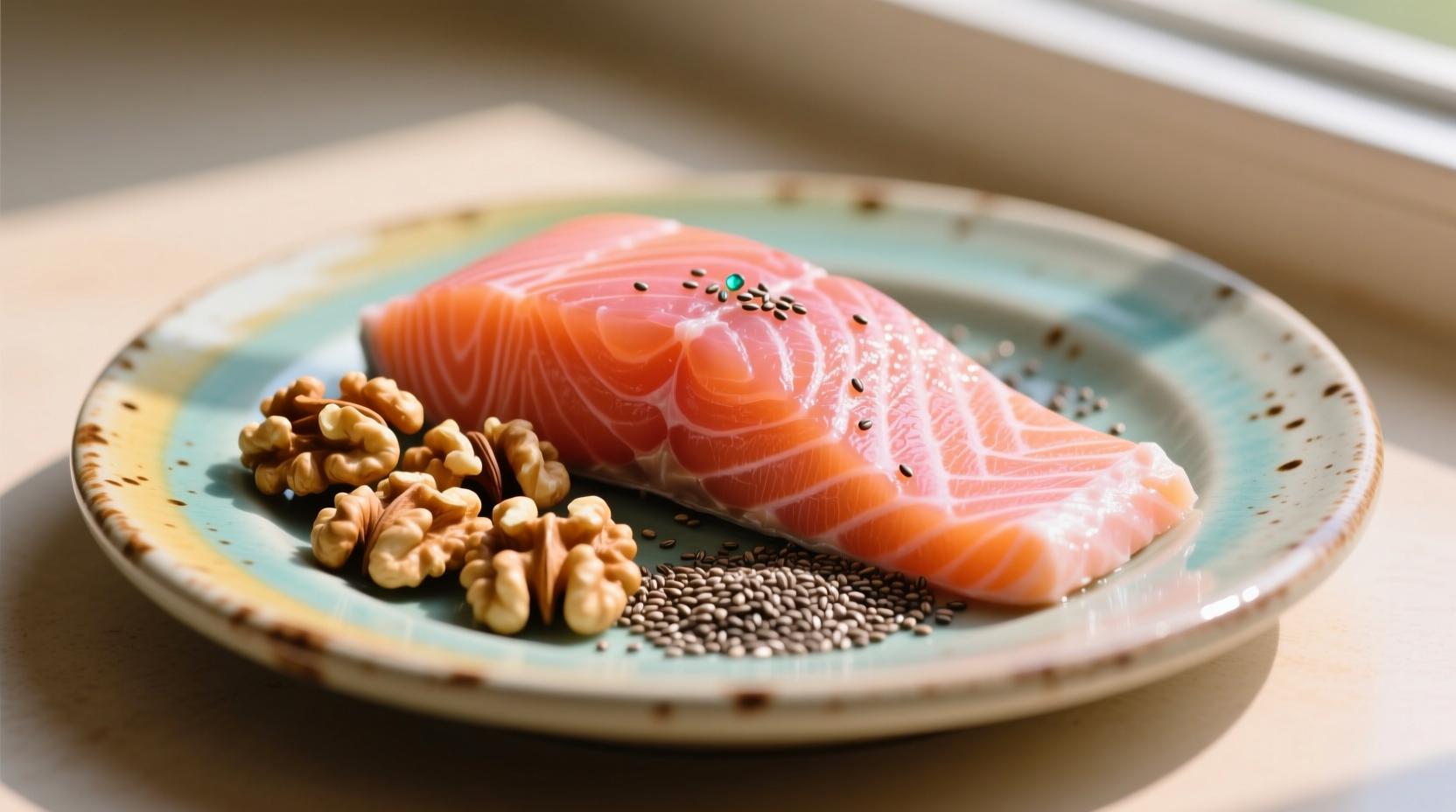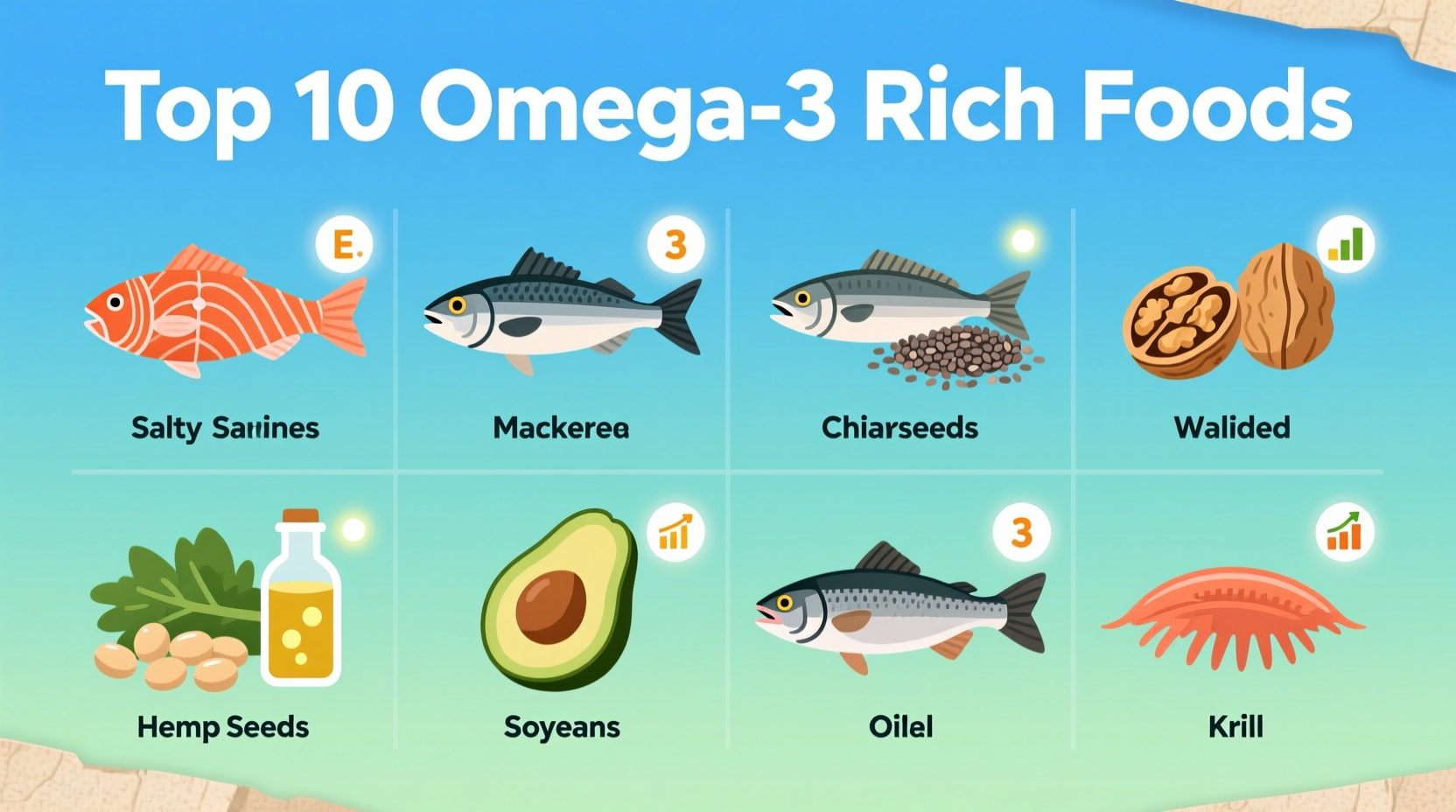The top foods highest in omega-3 fatty acids include fatty fish like salmon (4,123 mg per 3 oz), mackerel (5,134 mg), and sardines (2,205 mg), along with plant-based options such as flaxseeds (2,350 mg per tablespoon), chia seeds (5,060 mg per ounce), and walnuts (2,570 mg per ounce). For optimal health benefits, aim to consume 250-500 mg of combined EPA and DHA daily from marine sources, plus additional ALA from plant foods.
Discover exactly which foods deliver the most potent omega-3 benefits and how to incorporate them into your daily meals. This guide cuts through the confusion with science-backed recommendations you can trust—no fluff, just actionable nutrition insights that support heart health, brain function, and inflammation management.
Why Omega-3s Matter: Beyond the Basics
Omega-3 fatty acids aren't just another health trend—they're essential nutrients your body can't produce on its own. The three primary types serve distinct biological functions:
- EPA (eicosapentaenoic acid): Directly reduces inflammation and supports mood regulation
- DHA (docosahexaenoic acid): Critical for brain development and cognitive maintenance
- ALA (alpha-linolenic acid): Plant-based precursor that converts inefficiently to EPA/DHA
According to the National Institutes of Health, most adults consume only 10-20% of the recommended daily omega-3 intake. This nutritional gap contributes to increased risks for cardiovascular disease, cognitive decline, and inflammatory conditions. The American Heart Association recommends at least two 3.5-ounce servings of fatty fish weekly for optimal heart health.

Top 10 Omega-3 Power Foods Ranked by Nutritional Impact
Not all omega-3 sources deliver equal benefits. This ranking considers both quantity and bioavailability—the actual amount your body can use:
| Food Source | Omega-3 Content (per standard serving) | Type of Omega-3 | Bioavailability Rating |
|---|---|---|---|
| Mackerel (Atlantic) | 5,134 mg per 3 oz | EPA/DHA | ★★★★★ |
| Salmon (wild-caught) | 4,123 mg per 3 oz | EPA/DHA | ★★★★★ |
| Chia Seeds | 5,060 mg per ounce | ALA | ★★★☆☆ |
| Flaxseeds (ground) | 2,350 mg per tablespoon | ALA | ★★★☆☆ |
| Sardines (canned) | 2,205 mg per 3 oz | EPA/DHA | ★★★★☆ |
Marine Sources: The Most Effective Omega-3 Delivery System
Fatty fish provide pre-formed EPA and DHA that your body utilizes immediately—unlike plant-based ALA which requires conversion. Research from the National Center for Biotechnology Information shows marine sources deliver 5-10 times more usable omega-3s than plant alternatives.
When selecting fish, prioritize wild-caught varieties over farm-raised when possible. A 2023 analysis by the U.S. Food and Drug Administration found wild salmon contains 30% more DHA on average than farmed counterparts. For sustainable options, look for MSC (Marine Stewardship Council) certification.
Plant-Based Omega-3s: Maximizing Limited Conversion
Vegetarians and vegans can still meet omega-3 requirements through strategic food choices. While ALA conversion rates are low (5-10% to EPA, 2-5% to DHA), these techniques boost effectiveness:
- Grind flaxseeds before consumption—whole seeds pass through undigested
- Pair omega-3 foods with vitamin C-rich ingredients to enhance absorption
- Avoid heating oils high in omega-3s (like flaxseed oil) which damages delicate fats
- Consider algal oil supplements for direct DHA intake
The Academy of Nutrition and Dietetics confirms that properly planned plant-based diets can meet omega-3 requirements, but requires careful attention to food combinations and preparation methods.
Practical Integration: Simple Daily Strategies
Forget complicated meal plans—these effortless additions deliver consistent omega-3 intake:
- Breakfast boost: Stir 1 tbsp chia seeds into oatmeal or smoothies (adds 2,500 mg ALA)
- Lunch upgrade: Top salads with ¼ cup walnuts (provides 2,570 mg ALA)
- Dinner essential: Replace chicken with salmon twice weekly (delivers 8,000+ mg EPA/DHA)
- Smart snacking: Keep roasted seaweed snacks handy (contains DHA precursors)
Registered dietitians recommend rotating sources throughout the week to maximize nutrient diversity. For example, Monday's chia pudding, Wednesday's walnut-crusted fish, and Saturday's flaxseed pancakes create a balanced omega-3 profile.
Important Considerations and Limitations
While omega-3s offer significant health benefits, certain factors affect their effectiveness:
- Omega-6 ratio matters: High intake of processed vegetable oils (soybean, corn) creates imbalance that reduces omega-3 benefits
- Cooking methods impact: Frying fish at high temperatures degrades delicate omega-3 fats
- Individual variation: Genetic differences affect ALA conversion efficiency by up to 400%
- Medication interactions: High-dose omega-3s may interact with blood thinners
The American College of Cardiology notes that while omega-3 supplements benefit those with heart conditions, whole food sources provide additional nutrients like selenium and vitamin D that work synergistically with fatty acids.
Evolution of Omega-3 Understanding
Scientific understanding of omega-3s has evolved significantly over the past three decades:
- 1990s: Research focused primarily on cardiovascular benefits of fish consumption
- 2000s: Discovery of DHA's critical role in brain development and cognitive health
- 2010s: Recognition of inflammation-modulating properties across multiple body systems
- 2020s: Personalized nutrition approaches accounting for genetic variations in metabolism
This progression explains why early recommendations focused solely on fish consumption, while current guidelines emphasize diverse sources and individualized approaches.
Your Action Plan for Optimal Omega-3 Intake
Implement these evidence-based steps immediately:
- Consume fatty fish at least twice weekly (salmon, mackerel, herring)
- Add 1-2 tablespoons of ground flax or chia seeds to daily meals
- Replace omega-6 rich oils with canola or olive oil in cooking
- Store plant-based omega-3 sources in refrigerator to prevent oxidation
- Consider an algal oil supplement if following a strict plant-based diet
Track your progress with a simple food journal for two weeks. Most people notice improved skin hydration and reduced joint stiffness within 30 days of consistent intake. Remember that omega-3 benefits accumulate over time—this isn't a quick fix but a lifelong nutritional foundation.
Frequently Asked Questions
How much omega-3 do I really need daily?
The National Academies of Sciences recommends 1.1-1.6 grams of ALA daily for adults. For EPA and DHA specifically, most health organizations suggest 250-500 mg combined. Individual needs vary based on health status, age, and dietary patterns.
Can I get enough omega-3s from plant sources alone?
Yes, but it requires careful planning. Plant sources provide ALA which converts inefficiently to EPA/DHA. Vegetarians should consume 2-3 times more ALA and consider algal oil supplements for direct DHA intake to ensure adequate levels.
Does cooking destroy omega-3s in fish?
High-heat methods like frying can degrade up to 70% of omega-3s. Baking, steaming, or poaching at temperatures below 350°F preserves 90%+ of fatty acids. Always cook fish skin-side down first to protect the delicate fats.
How quickly will I notice benefits from increased omega-3 intake?
Initial improvements in skin hydration and joint comfort typically appear within 4-6 weeks. Significant cardiovascular and cognitive benefits require consistent intake for 3-6 months. Blood tests measuring omega-3 index provide the most accurate progress tracking.











 浙公网安备
33010002000092号
浙公网安备
33010002000092号 浙B2-20120091-4
浙B2-20120091-4